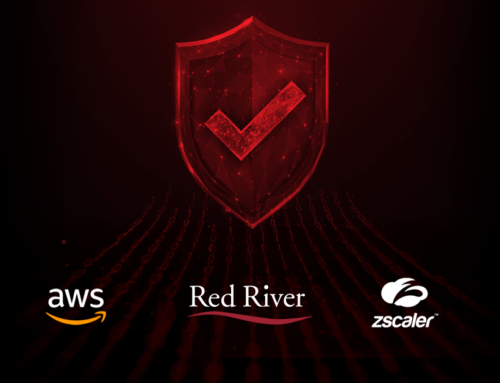
How to Transition Your Business to a Zero Trust Maturity Model
An alarming number of cyberattacks devastated businesses in 2023, and industry leaders are transitioning to a zero trust maturity model to better protect their digital assets.
Last year marked a reported 72 percent spike in individuals impacted by hackers since 2021. What is particularly troubling about that increase is that 2021 previously set the high-water mark. At the current pace, cybersecurity analysts anticipate cybercrime damages will exceed $10.5 trillion in 2025. Adding insult to injury, companies are expected to suffer an average of more than $1.3 million per data breach. The U.S. Department of Defense wants companies in the military industrial base to adopt a zero trust maturity model. It’s also prudent for other organizations that benefit from government contracts to adopt security measures to reduce risk.
The National Security Agency (NSA) recently released a cybersecurity information sheet advocating for organizations to transition. The NSA’s executive summary, “Embracing a Zero Trust Security Model,” hit the nail on the head.
“Systems that are designed using Zero Trust principles should be better positioned to address existing threats, but transitioning to such a system requires careful planning to avoid weakening the security posture along the way. The NSA continues to monitor the technologies that can contribute to a Zero Trust solution and will provide additional guidance as warranted,” the summary states. “To be fully effective to minimize risk and enable robust and timely responses, Zero Trust principles and concepts must permeate most aspects of the network and its operations ecosystem. Organizations, from chief executive to engineer and operator, must understand and commit to the Zero Trust mindset before embarking on a Zero Trust path.”
Given that a variety of studies conclude that hackers use endpoint devices 70 percent of the time to infiltrate corporate networks, the zero trust maturity model may be the most suitable, cost-effective way to protect sensitive personal data and valuable digital information.
What is the Zero Trust Maturity Model?
The zero trust maturity model starts with the premise that a sophisticated hacker possesses the skills, technology and tools to penetrate almost any network. Sadly, the increase in successful data breaches bears this point out. Zero trust strategies do not abandon anti-virus software, firewalls, extended detection methods or threat-hunting automation. Instead, the policy embraces a data-centric model that assumes hackers could win the day.
When a legitimate network user logs into the system, that individual can only access specific and limited digital assets and programs. Should a hacker learn a staff member’s login credentials, the online thief encounters the same restrictions. With personnel identity records, bank accounts and valuable trade information out of reach, companies can avoid catastrophic losses. Businesses that fail to transition to zero trust architecture leave critical data at risk.
Planning Ahead for Zero Trust
Adopting the zero trust maturity model suggested by the federal government requires painstaking analysis and planning. Few, if any, enterprises are turn-key ready to integrate the advanced technologies needed. The mish-mosh of hardware and software companies accumulate also make seamless adoption unlikely. Fortunately, a cybersecurity firm with managed IT experience can help navigate the planning process.
Assessing Your Current Security Posture
In cybersecurity circles, an organization’s “posture” typically refers to its ability to withstand a cyberattack. It involves wide-reaching aspects of digital and, to some degree, physical security measures. Assessing a company’s secure posture usually consists of running a series of simulations to determine how well they deter, detect and repel potential attacks. A managed IT firm with cybersecurity expertise may conduct a thorough risk assessment to identify vulnerabilities. With this information in hand, the third-party professionals meet with key stakeholders and members of the leadership team to map out critical next steps.
Defining Goals and Objectives
The primary goal of any zero-trust policy is to reduce risk. Other measures are in place to harden an operation’s attack surface. Zero trust serves as a type of fail-safe protocol. In other words, if a hacking gang puts enough time, energy and resources into penetrating the network, the criminals are blocked from stealing the most delicate and valuable data. These are common zero-trust policy goals to consider.
- Create a comprehensive checklist of digital assets by category.
- Identify the value and accompanying level of protection specific assets require.
- Establish criteria that each user profile meets and corresponding network access.
- Mandate login protocols for all in-house and endpoint devices.
- Develop steps for network users to gain temporary access to data outside their zero trust limitation.
Organization-specific goals and objectives are likely to be handled based on the risk assessment findings. All of these issues must be mapped out, analyzed and considered against the industry, processes, productivity expectations and type of data that requires fail-safe protection. Although the notion that hackers can pilfer off even the most well-protected data may cause a few restless nights, implementing a zero trust maturity model proves a wonderful elixir.
Implementing Zero Trust Maturity Model
A 2021 Executive Order on “Improving the Nation’s Cybersecurity” paved the way for the modernizing of the federal government’s cybersecurity posture. It speaks directly to advancing “toward Zero Trust Architecture.” Three years later, the mandate is finding its way into civilian operations and the federal government has a vested interest in protecting it. These are the pillars included in the federal government directive.
Device Authentication
Considered a foundational component of zero trust security, any device that attempts to log into a network must be authenticated, located, enumerated and assessed before getting the green light. Based on the real-time conclusions, a device may be approved or flagged as a risk and denied entrance. These are ways automated zero trust infrastructure works.
- Multi-Factor Authentication: Organizations continue to adopt multi-factor authentication strategies that send a secondary code for legitimate users to enter. The code is usually transmitted to another device or communication platform to keep it away from a potential threat actor who has hacked an endpoint device.
- Geolocation: Even endpoint devices that appear on the vetted and approved inventory list are pinged. Sophisticated hackers have ways of masking their identity and device. Geolocation determines the physical location of the login request. If 5G towers in an enemy state appear, the request is summarily denied.
It’s entirely possible for a cybercriminal to seize digital or physical control over otherwise legitimate endpoint devices. Once in control, hackers frequently attempt to plant malicious software in the network. A robust zero trust model can detect malware, alert cybersecurity professionals or terminate access.
Microsegmentation
Microsegmentation may stand as the most highly refined aspect of zero trust strategies. When implemented, it divides networks into compartments that can only be accessed through separate pathways. Each cubby, if you will, adheres to specific and unique cybersecurity policies.
Depending on how intricate decision-makers want to make microoperations, they can be honed down to separate the files and programs used by individual staff members. However, most companies segregate information based on job description and position when implementing these solutions.
Application Visibility
Application traffic is part of the microsegmentation process. Programs are separated, and the communication flow between users is defined. Layered application visibility serves as another safeguard against a widespread data breach.
Next-Generation Firewalls (NGFWs)
The advanced technologies used in NGFWs far exceed the capabilities of even enterprise-level firewalls. These applications enjoy an awareness component that enables them to analyze the ways users navigate the network. This next-gen approach has been particularly helpful in cloud-based systems.
By limiting the digital areas a hacker can enter, microsegmentation impedes cybercriminals from robbing an organization of privileged and valuable assets. Like policies that involve least privilege network access, hackers face restrictions.
Creating Least Privilege Login Credentials
The principle of least privilege — sometimes known as PoLP in cybersecurity circles — sets limits on data and application access. It also calls for users to gain permission anytime they need to venture into areas outside their parameters. This policy starts with decision-makers establishing policies that match workload roles with data and programs.
For instance, a graphic designer does not necessarily need to see corporate bank accounts or personnel files. Pragmatic in its approach to network access, least privilege also maintains the flexibility to grant temporary permissions to perform activities. When well-refined, it can allow employees to review select files in read-only mode.
As a safeguard, least privilege profiles are a hacker’s worst nightmare. After spending time, energy and resources learning a staff member’s username and password, the cybercriminal can only see what the limited profile allows.
Benefits of Zero Trust Architecture

The process of implementing zero trust architecture proves enlightening for industry leaders, as the risk assessment highlights the organization’s strengths and weaknesses. As the cybersecurity experts and management team move forward, information about existing technologies and others needed to create a determined cybersecurity posture come to light. Enhanced knowledge about an operation’s digital capabilities proves a useful goal-achievement tool. These are other commonly cited zero trust benefits.
- Regulatory Compliance: The federal government has made its data security wishes clear. On the heels of the Cybersecurity Maturity Model Certification (CMMC) initiative, Washington, D.C., wants zero trust infrastructure in place ASAP. By implementing it now, organizations can stay ahead of data protection mandates.
- Minimize Risk: Hackers make increasingly large ransomware demands once they take control of a corporate network. Others steal confidential data and sell it on the dark web. The financial losses from downtime, drained bank accounts and reputational damage can bankrupt a company. Zero trust detects, deters and repels most hacking attempts. Even if hackers log into the system using a staff member’s credentials, least privilege and segmentation hamstring thieves.
Part of any new policy should always involve cybersecurity awareness training. Articulating the reasons why least privilege and segmentation practices have been adopted helps avoid misunderstandings. Some staff members take zero trust as a personal affront until leadership brings them into the loop and a cybersecurity professional explains the wisdom behind it.
Zero Trust Challenges & Solutions
Change is never easy, and companies will face some headwinds when transitioning to the zero trust maturity model. Addressing integration can be a Herculean task because too many organizations have pieced together a variety of software, hardware and other components. For example, legacy hardware and software can be a significant challenge when attempting to incorporate next-generation firewalls.
Managing costs and other resources is also an issue to consider. While much of it can be automated, human decision-makers are typically needed to approve access permissions and review endpoint device rejections. These and other challenges unique to an organization can be overcome by working diligently with a managed IT firm that possesses zero trust cybersecurity expertise.
There are a number of good reasons to transition a business to the zero trust maturity model as soon as possible. The security measure helps companies meet or exceed regulatory compliance mandates and avoid penalties. As a fail-safe defense, it leaves hackers empty handed, and that reduces the risk of millions in monetary losses, as well as the sting of a tarnished business reputation. At the end of the day, zero trust security remains a cost-effective way to reduce risk in a sometimes hostile digital environment.
IMPLEMENT ZERO TRUST MATURITY MODEL WITH THE HELP OF RED RIVER
At Red River, we work with companies to create cybersecurity solutions that detect, deter and expel threat actors. If you are interested in integrating the zero trust maturity model strategy, contact us today. Let’s get the process started.

written by
Corrin Jones
Corrin Jones is the Director of Digital Demand Generation. With over ten years of experience, she specializes in creating content and executing campaigns to drive growth and revenue. Connect with Corrin on LinkedIn.




